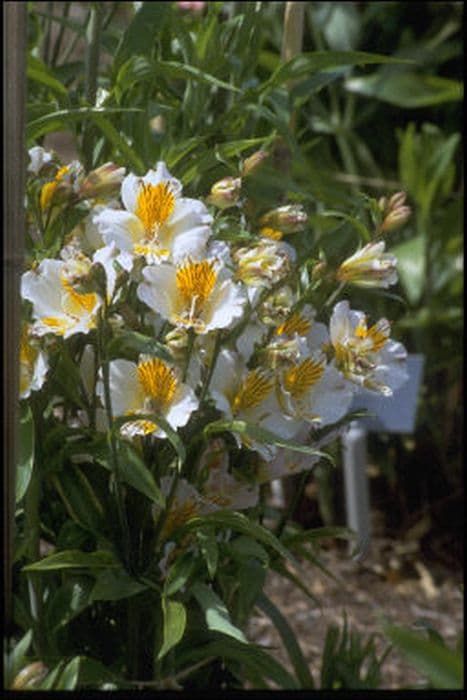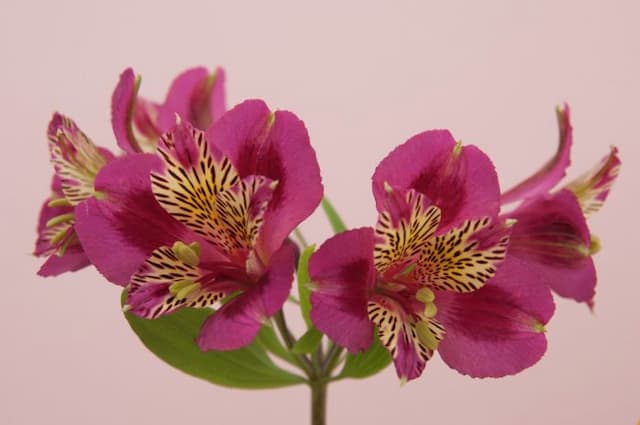Peruvian Lily Alstroemeria Princess Isabella = 'Zapribel' (PBR) (Princess Series)
![Peruvian lily [Princess Isabella]](/_next/image?url=https%3A%2F%2Fplants-admin.emdemapps.com%2Fimages%2Fplants%2F%2Fimages%2F604b5d8c896b9.png&w=3840&q=75)
ABOUT
The Alstroemeria Princess Isabella, which is part of the Princess Series, is a striking perennial plant known for its showy flowers and lush foliage. This variety is particularly notable for its blooms that come in a blend of vibrant pink and creamy white colors, often with speckles or streaks of dark pink or burgundy that give each petal a distinctive and eye-catching look. The flowers are trumpet-shaped and cluster together at the top of long, sturdy stems which can make them look quite stunning when they sway gently in the breeze. The leaves of Princess Isabella are narrow and lance-shaped, creating a dense backdrop of rich green that contrasts beautifully with the brightness of the flowers. The foliage can sometimes exhibit a unique twist or spiral effect, which adds to the plant's overall visual interest. With a combination of these striking flowers and attractive foliage, Alstroemeria Princess Isabella makes an excellent addition to ornamental gardens and is commonly used in bouquets and floral arrangements due to its longevity and appealing appearance.
About this plant
 Names
NamesFamily
Alstroemeriaceae.
Synonyms
Peruvian Lily, Lily of the Incas, Parrot Lily.
Common names
Alstroemeria Princess Isabella = 'Zapribel' (PBR) (Princess Series).
 Toxicity
ToxicityTo humans
The plant commonly known as Peruvian Lily is not considered highly toxic to humans, but it can cause minor skin irritations due to its slight dermal toxicity. If ingested, it may cause mild gastrointestinal upset, including nausea or vomiting. Handling the plant may sometimes result in dermatitis.
To pets
The Peruvian Lily is considered mildly toxic to pets, including cats and dogs. If a pet ingests this plant, they may experience mild gastrointestinal symptoms such as vomiting or diarrhea. It's advisable to prevent pets from eating or chewing on this plant to avoid these unpleasant reactions.
 Characteristics
CharacteristicsLife cycle
Perennials
Foliage type
Deciduous
Color of leaves
Green
Flower color
Mixed
Height
2 feet (60 cm)
Spread
1 foot (30 cm)
Plant type
Herb
Hardiness zones
7
Native area
South America
Benefits
 General Benefits
General Benefits- Long Blooming Period: The Alstroemeria, also known as Peruvian Lily, typically has a lengthy blooming season, providing vibrant colors for an extended period of time.
- Attracts Pollinators: Peruvian Lilies attract bees, butterflies, and other beneficial pollinators, contributing to the health of your garden ecosystem.
- Low Maintenance: Peruvian Lilies require minimal care once established, making them an ideal choice for gardeners seeking low-maintenance plants.
- Drought Tolerant: Once established, Peruvian Lilies can tolerate periods of drought, which is beneficial in regions with water restrictions or dry climates.
- Versatile Planting Options: They can be planted in borders, containers, and as cut flowers, offering a variety of uses in the garden and home.
- Cut Flower Longevity: The cut flowers of Peruvian Lilies are known for their longevity, often lasting two weeks or more in a vase.
- Colorful Varieties: The 'Zapribel' offers unique and vibrant color combinations, adding visual interest to any garden or floral arrangement.
- Cold Hardy: Peruvian Lilies are quite cold-resistant, surviving in USDA plant hardiness zones down to zone 7, which means they can be grown in many temperate regions.
 Medical Properties
Medical PropertiesThis plant is not used for medical purposes.
 Air-purifying Qualities
Air-purifying QualitiesThis plant is not specifically known for air purifying qualities.
 Other Uses
Other Uses- As a natural dye for fabrics: The colorful petals of the Alstroemeria can be used to produce natural dyes, creating a range of colors for textile art.
- Photography subject: With its striking blooms, photographers often use Alstroemeria Princess Isabella as a subject for macro photography and botanical art.
- In crafting handmade paper: The petals and leaves can be incorporated into the papermaking process to create decorative and textured papers.
- Floral art inspiration: The unique shape and colors of Alstroemeria blooms inspire artists to create paintings, drawings, and other floral-themed artworks.
- Eco-friendly confetti: Dried petals of Alstroemeria can be used as a biodegradable option for celebrations, replacing synthetic confetti.
- Bookmark creation: Pressed flowers of the Alstroemeria make for delicate and unique bookmarks.
- As a learning tool: Alstroemeria plants are used in horticultural programs to teach about plant hybridization and propagation methods.
- Culinary garnish: Although not widely known for its edibility, the petals can sometimes be used as a decorative garnish for desserts and salads after proper verification of non-toxicity.
- Mood enhancer: The vibrant colors of Alstroemeria can be used in color therapy practices to help lift spirits and create a positive atmosphere.
- Table setting decoration: Petals and whole blooms of the Alstroemeria can add a touch of elegance to special occasion table settings.
Interesting Facts
 Feng Shui
Feng ShuiThe Peruvian Lily is not used in Feng Shui practice.
 Zodiac Sign Compitability
Zodiac Sign CompitabilityThe Peruvian Lily is not used in astrology practice.
 Plant Symbolism
Plant Symbolism- Friendship: Alstroemeria, commonly known as Peruvian lily or lily of the Incas, is often associated with strong bonds of friendship due to its supportive and interwoven foliage, which symbolizes the interconnectedness between people.
- Wealth, Prosperity, and Fortune: The Peruvian lily is also a symbol of wealth and success, making it a common gift to wish someone good fortune in their endeavors or to celebrate achievements.
- Mutual Support: With leaves that twist as they grow, the Peruvian lily represents the twists, turns, and mutual support present in our relationships, encouraging an understanding of the importance of being there for each other.
- Devotion: The intricate flowers and long-lasting bloom of the Alstroemeria signify a steadfast devotion, often used to show someone that you're deeply committed to them or their cause.
- Achieving Aspirations: This plant is often seen as a beacon of motivation to reach one's goals due to its robust and vibrant blossoms that continuously strive upwards, symbolizing growth and the pursuit of dreams.
 Water
WaterFor the Peruvian Lily, ensure a regular and consistent watering schedule. Ideally, water the plant when the top inch of soil feels dry to the touch. Provide enough water to moisten the soil thoroughly, which could be around 1 to 2 gallons for outdoor plants or 16 to 32 ounces for smaller container plants, depending on size, approximately once a week. During the growing season in spring and summer, the Peruvian Lily may need more frequent watering, possibly every 3 to 4 days, while in winter, watering should be reduced. Always avoid waterlogging the soil as it can lead to root rot.
 Light
LightPeruvian Lilies thrive in bright, indirect sunlight, making them suitable for east or west-facing gardens where they can receive filtered light. They can tolerate full sun in cooler climates, but in hotter regions, they benefit from partial shade to protect them from intense midday sun. The ideal spot for the Peruvian Lily would be one that receives morning sunlight and afternoon shade, promoting healthy growth without risk of sunburn.
 Temperature
TemperaturePeruvian Lilies prefer temperature conditions between 65°F and 80°F, which are ideal for their growth. They can survive in temperatures as low as 23°F for short periods, but frost can be damaging, so protection or bringing them indoors during cold snaps is essential. During hot weather, temperatures above 90°F can cause stress to the plants, so it's best to provide some shade during the warmest part of the day.
 Pruning
PruningPruning Peruvian Lilies is done to encourage bushiness and more blooms, and to remove spent flowers or damaged foliage. The best time to prune is after flowering, cutting back stems that have finished blooming to the base. Regular deadheading of old flowers can also stimulate new growth. Pruning can be done every few weeks during the blooming season to maintain shape and encourage fresh blooms.
 Cleaning
CleaningAs needed
 Soil
SoilPeruvian Lily 'Princess Isabella' thrives in fertile, well-drained soil with a pH between 6.0 and 7.0. A mix of loamy soil with added organic matter such as compost or peat moss is ideal for ensuring adequate drainage and nutrient content.
 Repotting
RepottingPeruvian Lily 'Princess Isabella' typically requires repotting every 2 to 3 years to refresh the soil and provide room for growing roots. It's best to repot in the spring before the growing season begins.
 Humidity & Misting
Humidity & MistingPeruvian Lily 'Princess Isabella' prefers moderate humidity levels, around 40-60%. Consistent moisture in the air without being overly humid is conducive to healthy growth.
 Suitable locations
Suitable locationsIndoor
Provide bright indirect light and well-draining soil.
Outdoor
Plant in partial shade with shelter from strong winds.
Hardiness zone
7-10 USDA
 Life cycle
Life cycleAlstroemeria Princess Isabella, commonly known as Peruvian Lily, begins its life as a clump of rhizomes, which undergo a period of dormancy in winter. Upon the arrival of spring and warmer temperatures, new shoots emerge from the rhizomes, leading to the vegetative growth phase characterized by the development of lance-shaped leaves. As the plant matures, it enters the flowering stage, which can occur multiple times throughout the warmer months, producing vibrant blooms that often feature streaks or speckles. Following pollination, the Peruvian Lily may produce dry, capsule-like fruits, each containing multiple seeds, which are then dispersed, potentially giving rise to new plants. As temperatures cool, the above-ground parts of the plant begin to die back, signalling a return to dormancy, where the cycle is poised to repeat in the following growing season. This perennial cycle of growth, reproduction, and dormancy repeats yearly, allowing the Alstroemeria Princess Isabella to thrive and spread in suitable garden environments.
 Propogation
PropogationPropogation time
Spring to Summer
Alstroemeria Princess Isabella, commonly referred to as Peruvian Lily, is best propagated through division, which is typically done in the spring or early summer. This method involves carefully digging up an established clump of the plant and gently separating the tubers by hand, ensuring each division has at least one shoot. It is essential to handle the brittle tubers with care to prevent damage. Once divided, the tubers should be replanted in well-draining soil at the same depth they were previously growing. Water the newly planted divisions consistently until they are established.





![Peruvian lily [H.R.H. Princess Alice]](/_next/image?url=https%3A%2F%2Fplants-admin.emdemapps.com%2Fimages%2Fplants%2F%2Fimages%2F604b55e81c8b0.png&w=640&q=75)

![Peruvian lily [Inca Coral]](/_next/image?url=https%3A%2F%2Fplants-admin.emdemapps.com%2Fimages%2Fplants%2F%2Fimages%2F604b5b79b85ce.png&w=640&q=75)
![Peruvian lily [Inca Exotica]](/_next/image?url=https%3A%2F%2Fplants-admin.emdemapps.com%2Fimages%2Fplants%2F%2Fimages%2F604b5ec0e34a9.png&w=640&q=75)
![Peruvian lily [Inca Milk]](/_next/image?url=https%3A%2F%2Fplants-admin.emdemapps.com%2Fimages%2Fplants%2F%2Fimages%2F604b5f14b0b6a.png&w=640&q=75)